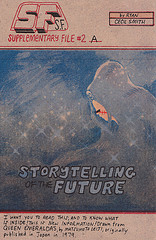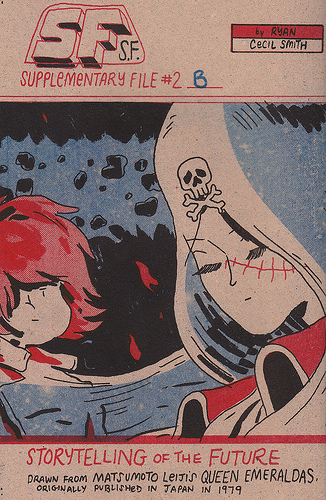 Ryan Cecil Smith: SF Supplementary File (Closed Caption)
Ryan Cecil Smith: SF Supplementary File (Closed Caption)
Space-age mystery, kitschy thrills, and futuristic adventure — what more could the discerning zine reader want? SF Supplementary File is the brainchild of Ryan Cecil Smith, an American-born cartoonist living and working in Nishinomiya, Japan.
The first SF and SF Supplementary File were part of the same coming-of-age saga in space, a mini-comic throwback to the Golden Age of pulp science fiction. SF Supplementary File #2, however, goes even further; the zine is “a hand-drawn, hand-written reproduction from Matsumoto Leiji’s 1979 science-fiction manga series Queen Emeraldas in three parts.” This piece of the ’70s, lovingly updated, offers the nostalgic thrill of cross-cultural and cross-generational kitsch reconfigured into a jewel-toned, hand-assembled, risograph-printed zine.
SF Supplementary File #2 follows Emeraldas, a space captain in the far-flung future, as she travels through space and forms a friendship with the mysterious Bottomless-Ocean Boy. The panels are simple but dynamic, with each page in a different color-and-white monochrome scheme, and the dialogue is sparse. There’s a sense of wonder in the story of two solitary travelers in space, and the minimalism seems appropriate for a tale set in the great void of uncharted space.
Despite the zine’s partly Japanese origins, readers expecting SFSF #2 to resemble typical manga will be disappointed. For all that his work incorporates elements of Japanese style, Smith feels that his aesthetic remains “North American.” For this zine Smith redrew panels from the manga, and his own style seems to have leaked in. He has been inspired by Japanese zines and art style, though: “There’s a really big zine culture here, as well as a ‘doujinshi’ (fan-art zine) scene. I think the ‘spirit’ of these cultures is something I love and try to feel when I make zines.” Fascination with space, and a taste for great exploration stories, are undoubtedly common to both cultures.
Even constrained as Smith was by cost and availability of papers, the physical product of SF Supplementary File #2 is quite a treat. Smith says of his process, “To me, it’s important to revel in / take advantage of the limitations of zine publishing. That includes the limited range of inks, of papers, and the number of people who will ever see this. Those are built into the concept of a zine.” The smaller print runs and limited range of materials may cut down on the options an author has, but they can also work in their favor and make the zine more special for those who do experience it.
In this case, Smith’s aesthetic goal was to not look like other zines on the Japanese market. Though I can’t speak for the Japanese side of things, he has definitely succeeded in setting himself apart from other American zines. SF #2’s pages are saturated with color, bright blues and reds, on lovely almost-newsprint-like paper. The interplay between solid color and white space really makes the book pop, and the whole endeavor feels very handmade, recalling an older, less slick era of comic books.
What’s next for SF Supplementary File? Smith is currently working on a real sequel to his first Supplementary File, making his manga translation more of a fun one-off than an ongoing series. However, when asked if he would ever translate manga again, Smith says, “I have no plans to do so, but if I do, then it will be very different from the way I did this one. Redrawing someone’s panels exactly so is hard. Translating a comic is fun, because Japanese is so different and you get to make a lot of personal choices as you do it.” Translating manga may be a lot of work, but the effort definitely shows in the final product — a lovely zine adventure for the kitsch-minded and the sci-fi fan.



